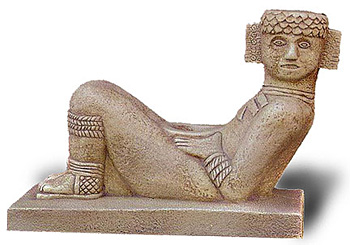 |
 |
 |
 News Around the Republic of Mexico | April 2007 News Around the Republic of Mexico | April 2007  
Mexico Finds Bones Suggesting Toltec Child Sacrifice
 Monica Medel - Reuters Monica Medel - Reuters


| Chac-Mool Maya Warrior - Temple of the Warriors, Chichen Itza, Mexico. 1000 A.D.
Chac Mools have been found across Mesoamerica, from El Salvador to Michoacan, although most of the best examples come from Chichen Itza and Tula. This Toltec style offertory figure is in its typical half-reclining position, supporting himself at the elbows, with its head turned to one side. The bowl held on the chests of Chac Mools were receptacles for offerings; in one Aztec example, the bowl held by the Chac Mool was a receptacle for the hearts of sacrificial victims. Chac Mools may symbolize fallen warriors who deliver offerings to the gods. The original of this Chac Mool is located in a wide platform in front of the entrance to the Temple of the Warriors in Chichen Itza; it is positioned between two large splendidly carved feathered serpent columns that symbolize the god Kukulcan. The term Chac Mool was coined by the 19th century explorer Augustus LePlongeon. |
The grisly find of the buried bones of 24 pre-Hispanic Mexican children may be the first evidence that the ancient Toltec civilization sacrificed children, an archeologist studying the remains said on Monday.

The bones, dating from 950 AD to 1150 AD and dug up at the Toltecs' former capital Tula, north of present day Mexico City, indicated the children had been decapitated in a group.

The way the children, aged between 5 and 15, were placed in the grave, and the fact they were buried with a figurine of Tlaloc, the God of rain, also pointed to a group sacrifice, archeologist Luis Gamboa said.

"To try and explain why there are 24 bodies grouped in the same place, well, the only way is to think that there was a human sacrifice," he said.

"You can see evidence of incisions which make us think they possibly used sharp-edged instruments to decapitate them."

The Toltecs were a war-like pre-Aztec civilization known for sacrificing adult humans - mainly prisoners of war - to the Gods.

Based in the ancient city of Tula, about 50 miles north of Mexico City, they flourished until the late 12th century, influencing much of Mexico from the southwestern United States down to the Gulf of Mexico and Central America.

Tula is best known today for its fearsome 15-foot-high (4.5 meter) stone warrior figures.

The children's bones were discovered by accident at the end of March by construction workers deepening the foundations of an office building in Tula, outside the archeological zone.

"In terms of children, it can be considered one of the first discoveries (in Toltec culture)," Gamboa said, adding that the children were likely brought in from other parts of Mexico. | 
 | |
 |



